Related Research Articles
Ur was an important Sumerian city-state in ancient Mesopotamia, located at the site of modern Tell el-Muqayyar in Dhi Qar Governorate, southern Iraq. Although Ur was once a coastal city near the mouth of the Euphrates on the Persian Gulf, the coastline has shifted and the city is now well inland, on the south bank of the Euphrates, 16 km (10 mi) from Nasiriyah in modern-day Iraq. The city dates from the Ubaid period c. 3800 BC, and is recorded in written history as a city-state from the 26th century BC, its first recorded king being King Tuttues.
Lagash was an ancient city state located northwest of the junction of the Euphrates and Tigris rivers and east of Uruk, about 22 kilometres (14 mi) east of the modern town of Al-Shatrah, Iraq. Lagash was one of the oldest cities of the Ancient Near East. The ancient site of Nina is around 10 km (6.2 mi) away and marks the southern limit of the state. Nearby Girsu, about 25 km (16 mi) northwest of Lagash, was the religious center of the Lagash state. The Lagash state's main temple was the E-ninnu at Girsu, dedicated to the god Ningirsu. The Lagash state incorporated the ancient cities of Lagash, Girsu, Nina.

Puabi, also called Shubad or Shudi-Ad due to a misinterpretation by Sir Charles Leonard Woolley, was an important woman in the Sumerian city of Ur, during the First Dynasty of Ur. Commonly labeled as a "queen", her status is somewhat in dispute, although several cylinder seals in her tomb, labeled grave PG 800 at the Royal Cemetery at Ur, identify her by the title "nin" or "eresh", a Sumerian word denoting a queen or a priestess. Puabi's seal does not place her in relation to any king or husband, possibly indicating that she ruled in her own right. It has been suggested that she was the second wife of king Meskalamdug. Although little is known about Puabi's life, the discovery of Puabi's tomb and its death pit reveals important information as well as raises questions about Mesopotamian society and culture.

Mesannepada (Sumerian: 𒈩𒀭𒉌𒅆𒊒𒁕, Mesannipàdda [MES-AN-NE2-PAD3-DA]), Mesh-Ane-pada or Mes-Anne-pada ("Youngling chosen by An") was the first king listed for the First Dynasty of Ur (c. 26th century BC) on the Sumerian king list. He is listed to have ruled for 80 years, having overthrown Lugal-kitun of Uruk: "Then Unug (Uruk) was defeated and the kingship was taken to Urim (Ur)". In one of his seals, found in the Royal Cemetery at Ur, he is also described as king of Kish.
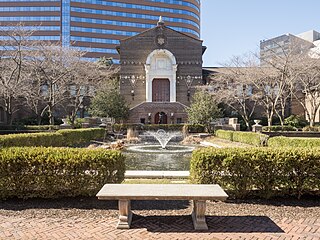
Penn Museum, formerly known as The University of Pennsylvania Museum of Archaeology and Anthropology, is an archaeology and anthropology museum at the University of Pennsylvania. It is located on Penn's campus in the University City neighborhood of Philadelphia, at the intersection of 33rd and South Streets. It also is close enough for Drexel University students to walk or take SEPTA transportation services. Housing over 1.3 million artifacts, the museum features one of the most comprehensive collections of Middle and Near-Eastern art in the world.

The Proto-Elamite period, also known as Susa III, is a chronological era in the ancient history of the area of Elam, dating from c. 3100 BC to 2700 BC. In archaeological terms this corresponds to the late Banesh period. Proto-Elamite sites are recognized as the oldest civilization in Iran. The Proto-Elamite script is an Early Bronze Age writing system briefly in use before the introduction of Elamite cuneiform.
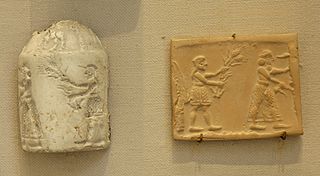
A cylinder seal is a small round cylinder, typically about one inch in length, engraved with written characters or figurative scenes or both, used in ancient times to roll an impression onto a two-dimensional surface, generally wet clay. According to some sources, cylinder seals were invented around 3500 BC in the Near East, at the contemporary sites of Uruk in southern Mesopotamia and slightly later at Susa in south-western Iran during the Proto-Elamite period, and they follow the development of stamp seals in the Halaf culture or slightly earlier. They are linked to the invention of the latter's cuneiform writing on clay tablets. Other sources, however, date the earliest cylinder seals to a much earlier time, to the Late Neolithic period in Syria, hundreds of years before the invention of writing.

Meskalamdug was an early Sumerian ruler of the First Dynasty of Ur in the 26th century BCE. He does not appear in the Sumerian King List, but is known from a royal cylinder seal found in the Royal Cemetery at Ur, a royal bead inscription found in Mari, both mentioning him as King, and possibly his tomb, grave PG 755 at the Royal Cemetery at Ur.
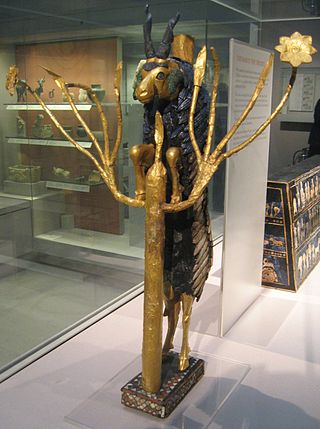
The Ram in a Thicket is a pair of figures excavated at Ur, in southern Iraq, which date from about 2600–2400 BC. One is in the Mesopotamia Gallery in Room 56 of the British Museum in London; the other is in the University of Pennsylvania Museum in Philadelphia, USA.
Tell Billa is an archaeological site near Bashiqa in Nineveh Province (Iraq) 20 kilometers northeast of Mosul.

Edith Porada was an Austrian-born art historian and archaeologist, a leading authority on ancient cylinder seals and a professor of art history and archaeology at Columbia University.
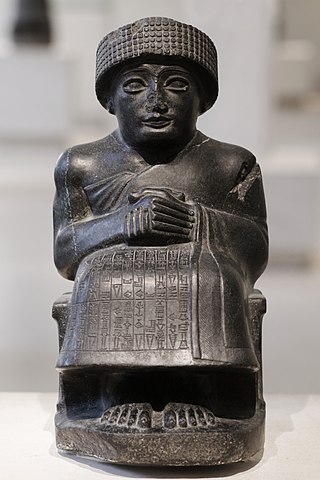
The art of Mesopotamia has survived in the record from early hunter-gatherer societies on to the Bronze Age cultures of the Sumerian, Akkadian, Babylonian and Assyrian empires. These empires were later replaced in the Iron Age by the Neo-Assyrian and Neo-Babylonian empires. Widely considered to be the cradle of civilization, Mesopotamia brought significant cultural developments, including the oldest examples of writing.
The Graduate Group in the Art and Archaeology of the Mediterranean World (AAMW) is an interdisciplinary program for research and teaching of archaeology, particularly archaeology and art of the ancient Mediterranean, Egypt, Anatolia, and the Near East, based in the Penn Museum of the University of Pennsylvania.

Two main types of seals were used in the Ancient Near East, the stamp seal and the cylinder seal. Stamp seals first appeared in 'administrative' contexts in central and northern Mesopotamia in the seventh millennium and were used exclusively until the fifth millennium. Cylinder seals appeared first around 3600 BC in southern Mesopotamia and south-western Iran. They gradually replaced stamp seals, becoming the tool of a rising class of bureaucrats in the early stages of state formation. Even though stamp seals were still produced in the third and second millennia, cylinder seals predominated. In the first millennium, stamp seals made a strong comeback and eventually replaced cylinder seals entirely.

The Royal Cemetery at Ur is an archaeological site in modern-day Dhi Qar Governorate in southern Iraq. The initial excavations at Ur took place between 1922 and 1934 under the direction of Leonard Woolley in association with the British Museum and the University of Pennsylvania Museum of Archaeology and Anthropology in Philadelphia, Pennsylvania, United States.
Jeanny Vorys Canby was an American archaeologist and scholar of the ancient Near East. She is best known for her restoration of the Ur-Nammu stele.
Horace Howard Furness Jayne was an American museum director and curator, art historian, and expert on Asian art who served as the director of the University of Pennsylvania Museum of Archeology and Anthropology and the vice-director of the Metropolitan Museum of Art.
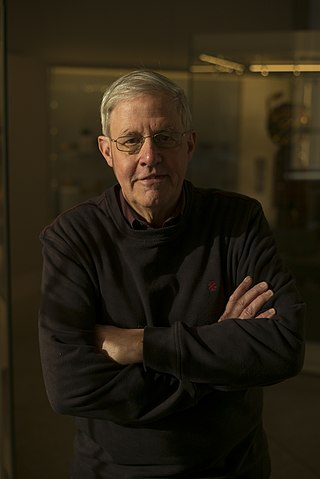
Richard L. Zettler is an American archaeologist of Early Bronze-Age Mesopotamia, with special interests in urban development and the organization of complex societies. At the University of Pennsylvania, he is a professor in the Department of Near Eastern Languages and Civilizations at the University of Pennsylvania and serves as Associate Curator-in-Charge of the Penn Museum’s Near East section. Working in partnership with colleagues from the University of Mosul and with Iraq’s State Board of Antiquities and Heritage, Zettler secured a three-year grant from the U.S. State Department in 2018 to identify and where possible to restore historic structures damaged by the Islamic State (ISIS) fighters who held Mosul from 2014 to 2017. This project has since expanded into the Mosul Heritage Stabilization Program (MHSP), which has also received funds from the Swiss foundation known as the International Alliance for the Protection of Heritage in Conflict Areas (ALIPH).
Dominique Petronella Margaret Collon, is a Belgian-born academic, author, archaeologist and former curator at the British Museum in London who has worked and travelled extensively in the Near East in Syria, Turkey and Iraq. She is an authority on cylinder seals.
Pašime,, was an ancient region of southern Mesopotamia. It has recently been identified with Tell Abu Sheeja, Iraq, about 7 km from Iraq's border with Iran. It lies about 70 kilometers southeast of modern Baghdad and 60 kilometers north of the modern city of Amarah. Pashime corresponded to an area of interaction between Mesopotamia and Elam and was occupied from the Ubaid and Uruk periods in the 4th Millennium BC until the Old Babylonian period in the early 2nd Millennium BC. Its tutelary god was Šuda. The city is known from texts to have bordered on the ancient polity of Huhnur. The city of Pašime is thought to have been on the Persian Gulf which at that time extended much further north.
References
- ↑ "Holly Pittman | Penn History of Art". www.sas.upenn.edu. University of Pennsylvania. Retrieved 2 March 2017.
- ↑ kel306 (2012-10-23). "Holly Pittman". Institute for the Study of the Ancient World. Retrieved 2017-04-04.
{{cite news}}: CS1 maint: numeric names: authors list (link) - 1 2 Olszewski, Deborah I. (2006). "Meet the Curators: Holly Pittman, Curator, Near East Section". Expedition Magazine. Vol. 48, no. 2 – via Penn Museum Website.
- ↑ "The Jiroft Civilization: A New Culture of the Bronze Age on the Iranian Plateau | Research – Penn Museum". www.penn.museum. Retrieved 2020-03-27.
- ↑ Madjidzadeh, Youssef; Pittman, Holly (2008). "Excavations at Konar Sandal in the Region of Jiroft in the Halil Basin: First Preliminary Report (2002–2008)". Iran. 46: 69–103. doi:10.1080/05786967.2008.11864738. ISSN 0578-6967. JSTOR 25651436. S2CID 194883051.
- ↑ "Survey and Excavation at Al-Hiba, Dhi Qar Province, Iraq" (PDF). Department of Ancient Near Eastern Art Newsletter. 3: 11. 2019. Retrieved 7 April 2020.
- ↑ "The Al-Hiba Publication Project". al-hiba.net. Retrieved 2020-03-27.
- ↑ "Penn Museum opens new Middle East gallery". WHYY. Retrieved 2020-03-27.
- ↑ "Middle East Galleries". www.penn.museum. Retrieved 2020-03-27.
- ↑ Swartz, Laura (2018-04-18). "Penn Museum Unveils New Middle East Galleries". Philadelphia Family Magazine. Retrieved 2020-03-27.
- ↑ "Sneak peek: Inside the new Middle East Galleries at the Penn Museum". pennlive. 2018-04-19. Retrieved 2020-03-27.
- ↑ "Revealing Penn Museum's Middle East treasures". Penn Today. 16 April 2018. Retrieved 2020-03-27.
- ↑ "Iraq's Ancient Past: Rediscovering Ur's Royal Cemetery" . Retrieved 2020-03-27.
- ↑ "10/27/09, Iraq's Ancient Past: Rediscovering Ur's Royal Cemetery – Almanac, Vol. 56, No. 09". almanac.upenn.edu. Retrieved 2020-03-27.
- ↑ "Iraq's Ancient Past: Rediscovering Ur's Royal Cemetery". Penn Today. 8 October 2009. Retrieved 2020-03-27.
- ↑ Emberling, Geoff; Petit, Lucas P. (September 6, 2018). Museums and the ancient Middle East : curatorial practice and audiences. Routledge. pp. 180–181. ISBN 978-0815349723 . Retrieved 7 April 2020.
- ↑ "Expedition Magazine – Penn Museum". www.penn.museum. Retrieved 2020-03-27.
- ↑ "Treasures from the Royal Tombs of Ur | McClung Museum of Natural History & Culture". mcclungmuseum.utk.edu. 14 September 2016. Retrieved 2020-03-27.
- ↑ "Treasures from the Royal Tombs of Ur | Middlebury College Museum of Art". museum.middlebury.edu. Retrieved 2020-03-27.
- ↑ "Treasures From The Royal Tombs Of Ur | The Oriental Institute of the University of Chicago". oi.uchicago.edu. Retrieved 2020-03-27.
- ↑ Pittman, Holly (1987). Ancient Art in Miniature: Ancient Near Eastern Seals from the Collection of Martin and Sarah Cherkasky. The Metropolitan Museum of Art. ISBN 0300193009.
- ↑ Reif, Rita (October 11, 1987). "ANTIQUES; Seals That Offer Images of the Past". The New York Times. p. A42.
- ↑ Katz, William A.; Dahl, Svend (1995). Dahl's history of the book (3rd English ed.). Lanham, MD & London: Scarecrow Press. p. 31. ISBN 9780810828520 . Retrieved 7 April 2020.
- ↑ Pittmann, Holly; Crawford, Vaughn E.; Harper, Prudence O.; Frank, Dorothea Seelye (1979). Assyrian Reliefs and Ivories in The Metropolitan Museum of Art: Palace Reliefs of Assurnasirpal II and Ivory Carvings from Nimrud. The Metropolitan Museum of Art. ISBN 0300193068.
- ↑ Pittman, Holly; Harper; Muscarella; Porter; Spar (1984). "Ancient Near Eastern Art": The Metropolitan Museum of Art Bulletin, v. 41, no. 4 (Spring, 1984). The Metropolitan Museum of Art.
- ↑ Russell, John (1975-04-18). "Met Shows Scythian Art With Skill". The New York Times. ISSN 0362-4331 . Retrieved 2020-03-27.